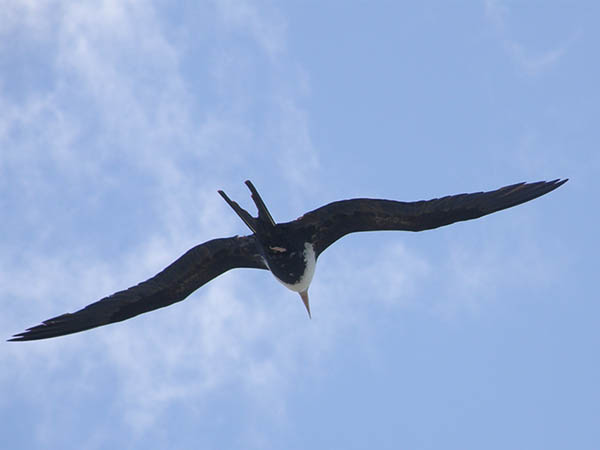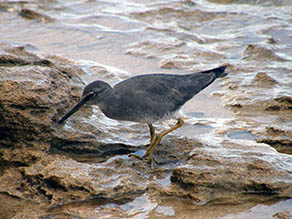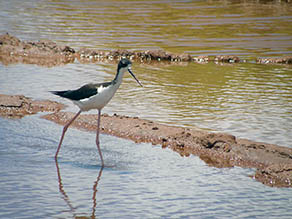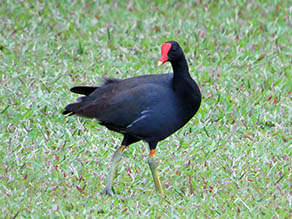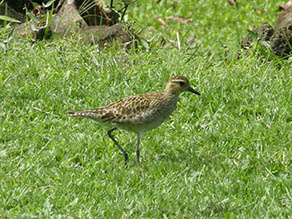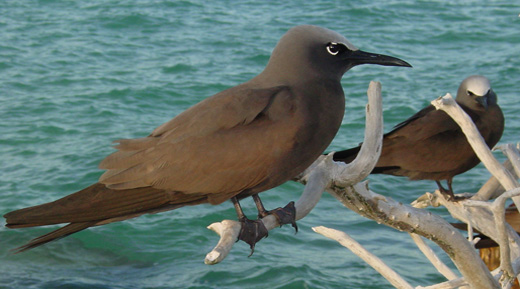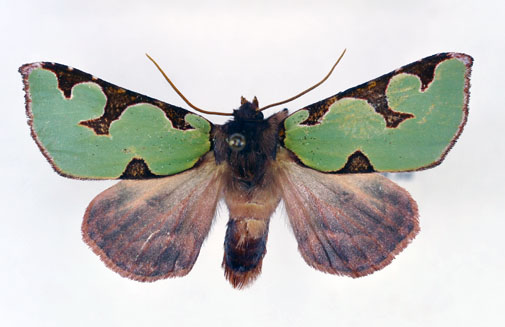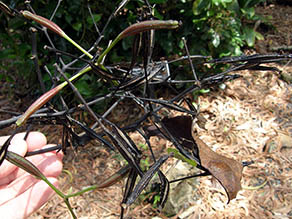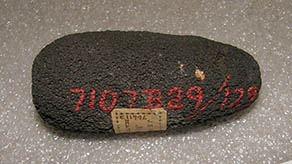 |
 |
 |
 |
||||||
|
|
|
|
|
|
|
|
|
|
|
| Areas | Seasons | Forest | Ocean | Sky | Language | Sources & Links | |||||||||
 |
Frigate bird (“iwa) in flight.
|
 |
|||||||
 |
“You could say that we have four classes of birds,” Kawika begins, “and these are functional classes, based on where they fit into the whole system. Each of these groups is culturally significant for different reasons. “Starting from the bottom of the ahupua‘a, we have the coastal seabirds, like the ‘ūlili, and ‘ua‘u kani. Some of them forage along the shoreline, and others feed in the deeper waters, but they have their burrows along the coast line. “The next one that we have that’s important now is the water fowl—the ones that you see around the taro patches and the streams and the estuaries. These include the ‘alae ‘ula (the mudhen), the ‘alae ke‘oke‘o (the coot), the ae‘o (a stilt), and the ‘auku‘u, which is the night heron. Those are kinds of fresh water birds. “The ‘alae ‘ula has a lot of stories, very prominent stories, I think because that was more of the bird that was really common in taro patches and so it’s easier to have a really close relationship with it. The ‘alae ‘ula was really important in the Maui story. There is part of the Maui story is about his mom and how they learned to make fire. “Also there is its relationship to taro. The coot with the white instead of red, on other islands is called the ‘alae ke‘oke‘o. On our island it’s called nūkea. It’s a contraction of nuku kea—nuku is the beak, it’s the white (kea) beak. So it’s the name for the bird in this area of Kaua‘i. Uncle Tom, before he started farming commercial taro, he was farming the old varieties of taro. There were eight he used to grow. And they include two variants of nūkea. “The old Hawaiians, they would name plants based on relationships that they would see around them—a tendency of pairing and duality that is really evident in the Kumulipo, but it’s not limited to the Kumulipo—so that a lot of the plants have fish names, or a lot of fish have plant names, so this is an example of the taro sharing the name with a particular bird, which is kind of cool little caveat. So here is an example of that pairing and that duality that isn’t really documented anywhere else, or talked about anywhere else except here in Hā‘ena. “A little bit inland is the kōlea, the Pacific Golden Clover. It’s a migratory bird—it goes between here and Alaska. There are proverbs about that, similar to the one where—when there is something you know is never going to happen—you say ‘Yeah, right, when pigs fly.’ You that know pigs are never going to fly. The Hawaiian version of that is ‘Yeah, when you see the egg of the kōlea.’ Nobody ever sees the egg of kōlea, because it goes to Alaska to breed and lay its eggs. It comes here only in the winter time, to feed and get fat. And then it leaves. “In the 1800’s and early 1900’s, ‘kōlea’ started to be a kind of insulting term that was applied to foreigners who had just come to Hawai‘i and get fat and then leave, not really doing anything to contribute to the place. So in the old days, if you were called a kōlea, it wasn’t a good thing. Which is kind of funny because there are people who refer to themselves as ‘snowbirds,’ who move to Hawai‘i or other warm places during the winter, then go back to where they came from. “Above that is our forest birds, which nowadays—because of the mosquito-born avian diseases—they are only in the uplands. We don’t see them in the lowlands anymore. But those are things like our honeycreepers and our flycatchers. I would include the pueo, which is technically a raptor, but the short-eared owl is kind of classed in the forest birds for me. “The ‘amakihi, ‘apapane, ‘i‘iwi, and ‘anianiau are the important ones that we still have in the upper valley that we would hope to have one back again in our lower valley. Beyond that there is the ‘elepaio which a flycatcher, another endangered species. And every island has its own thrush. The thrush on Kaua‘i was called pueohi, and other islands there are different species that were called either ‘ōma‘o or kāma‘o. They might all be extinct on the other islands. The Kaua‘i thrush is down to like less than 500 breeding pairs, which for birds is pretty much near extinction. “Above that we have our ground-nesting seabirds that are in the upper forest. In Hā‘ena we have the ‘a‘o (Newell Shearwater) and the ‘ua‘u (Hawaiian petrel). These are so rare, they are so critically endangered, that very few people even know they exist and don’t understand their role in the culture or how they function in the forest.
The noio (brown noddy). Photo by Ian Jones/USFWS. “Culturally these are really important birds for navigation. In the old days, when there were master navigators around, the master navigators would know the different seabird species and their habitats and their life cycles, such that if they’re out in the ocean and they saw this particular species fly by their canoe, depending on which direction it was flying, and according to the species and the season, they would know if that bird is flying towards land or away from land. So if you’re lost in the ocean, it’s really important to know what directions which species are going. If you’re trying to find land, you go towards where it’s indicating land is. “The noio and the Fairy Tern are some of the best examples of current navigation traditions, and these birds have different cycles. So in the ancient days, every species and its seasonal patterns and behaviors would be known.”
“The ‘Aumakua Hawk Moth was thought to be extinct on the island. It was rediscovered in our upper valley. Having this greenish, black moth that’s up in the forest that lives on our scianias, and knowing the Hawaiian name for that was the ‘aumakua, kind of gives an indication to us that these things were regarded as part of the spirit realm, or physical manifestations of the spirit realm. But they have a function that’s really important: any of our native flowers that are white are moth-pollinated. So the big co-evolutionary drivers for our really unique diversity has been moths and birds. "We had one founder [plant] and it started to kind of diversified its form, and then one made a co-evolutionary relationship with a bird and went off on this evolutionary track and this other group made a co-evolutionary with the moth and went up on this evolutionary track and we end up with these two completely different looking species that have a common ancestor but they just made co-evolutionary relationships with two different groups in the animal kingdom—a moth and an a honey creeper—and ended up with this amazingly different evolutionary forms. "I think a lot of the hawk moths, they kind of just hover over the flower and their proboscis will, and drink—I’m not quite sure. I don’t understand how they pollinate the flowers, but they do. So you can ask an entomologist about that. “Pāpala kēpau was used to catch birds,” Merlin explains. “the glue that is on the outside of the seed casing was used for spreading on little branches to catch birds, by the Hawaiian. And actually we will find those stuck to our bodies too back here when we’re working sometimes, they’ll fall. “Oh what is this? oh, it’s pāpala kēpau seed.” “You can eat all of these birds, Kawika adds, “and there are ways to cook them. There are pieces in the old Hawaiian newspapers about how to cook each bird. Up in the mountains, they would make a fire, and you’d make your stones red hot and then you’d stuff them in the belly of the bird, and then you’d put it all in a gourd, cover the thing and it just kind of like steams in the gourd. "And then it’s cooked and it’s fat and yummy.”
|
 |
|||
 |
The environmental zones and living beings of Hā‘ena provide the context in which the people of this land derived their Sustenance.
|
 |
||
 |
|
 |
||

|
|
||||
| Copyright 2018 Pacific Worlds & Associates • Usage Policy • Webmaster |
||||
